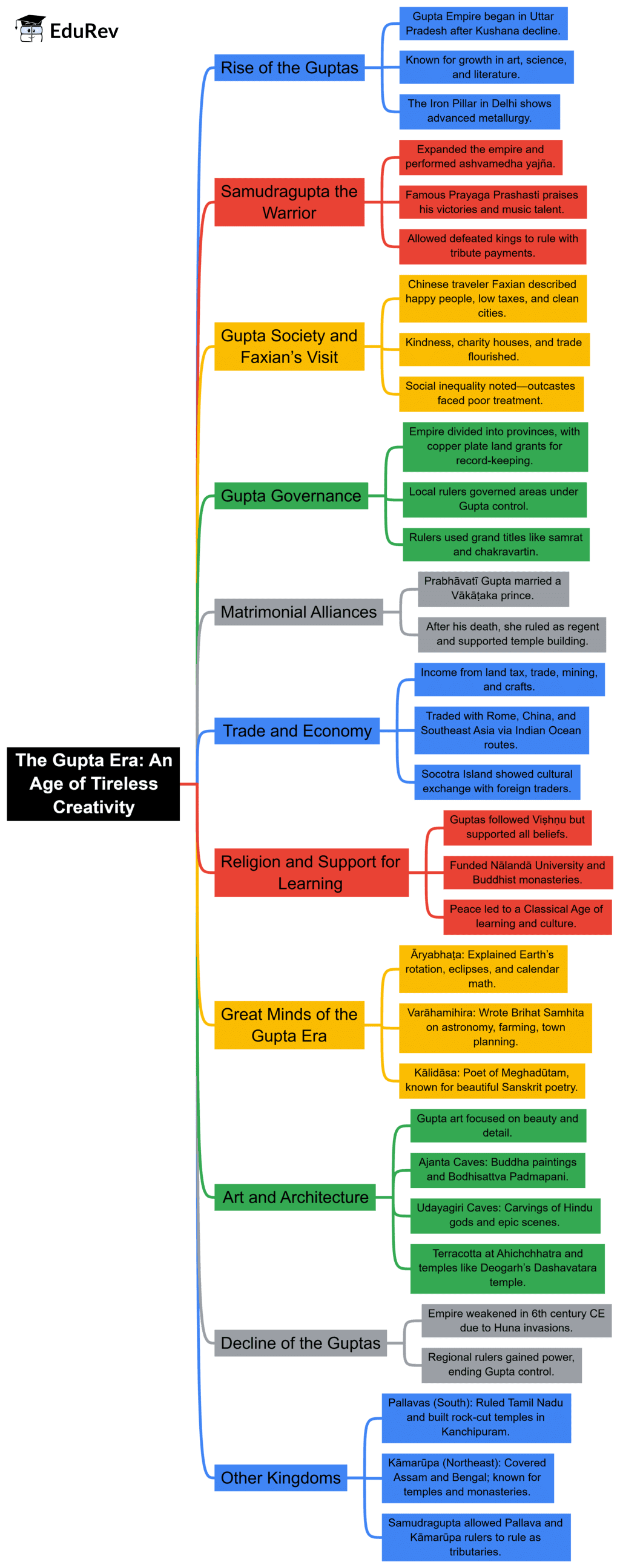Class 7 Exam > Class 7 Notes > Subject-Wise Mind Maps for Class 7 > Mind Map: The Gupta Era: An Age of Tireless Creativity
Class 7 Social Science Chapter 7 Mindmap - The Gupta Era: An Age of Tireless Creativity

The document Class 7 Social Science Chapter 7 Mindmap - The Gupta Era: An Age of Tireless Creativity is a part of the Class 7 Course Subject-Wise Mind Maps for Class 7.
All you need of Class 7 at this link: Class 7
FAQs on Class 7 Social Science Chapter 7 Mindmap - The Gupta Era: An Age of Tireless Creativity
| 1. What were the main achievements of the Gupta Empire during its golden age? |  |
Ans. The Gupta Empire, often referred to as a golden age of India, saw significant advancements in various fields. Key achievements included remarkable progress in mathematics, such as the concept of zero and the decimal system. In literature, famous works like Kalidasa's plays were produced, while in science, notable contributions were made in astronomy and medicine, including the surgical techniques of Sushruta.
| 2. How did the Gupta Empire influence art and architecture? |  |
Ans. The Gupta Era is known for its unique contributions to art and architecture. Temples were built with intricate carvings and sculptures, showcasing religious themes. The famous Ajanta and Ellora caves, with their stunning frescoes and rock-cut architecture, are prime examples of Gupta artistry. This period also saw the development of classical dance and music, further enhancing the cultural landscape.
| 3. What role did trade play in the Gupta Empire's economy? |  |
Ans. Trade was crucial to the Gupta Empire's economy, as it facilitated the exchange of goods such as textiles, spices, and precious stones. The empire established trade routes that connected India with regions in Southeast Asia, the Middle East, and beyond. This not only boosted economic prosperity but also encouraged cultural exchanges and the spread of ideas.
| 4. Who were some notable scholars and scientists of the Gupta Era? |  |
Ans. The Gupta Era produced several renowned scholars and scientists. Aryabhata was a prominent mathematician and astronomer known for his work in algebra and the calculation of the Earth's circumference. Another notable figure was Varahamihira, who made significant contributions to astronomy and astrology. These scholars laid the groundwork for future scientific advancements in India and beyond.
| 5. How did the decline of the Gupta Empire occur? |  |
Ans. The decline of the Gupta Empire was attributed to several factors, including internal strife, weak leadership, and external invasions. The empire faced challenges from regional powers and the Huns, which weakened its control. Economic difficulties and loss of trade routes also contributed to the decline, leading to the eventual fragmentation of the empire into smaller states.
Related Searches





















